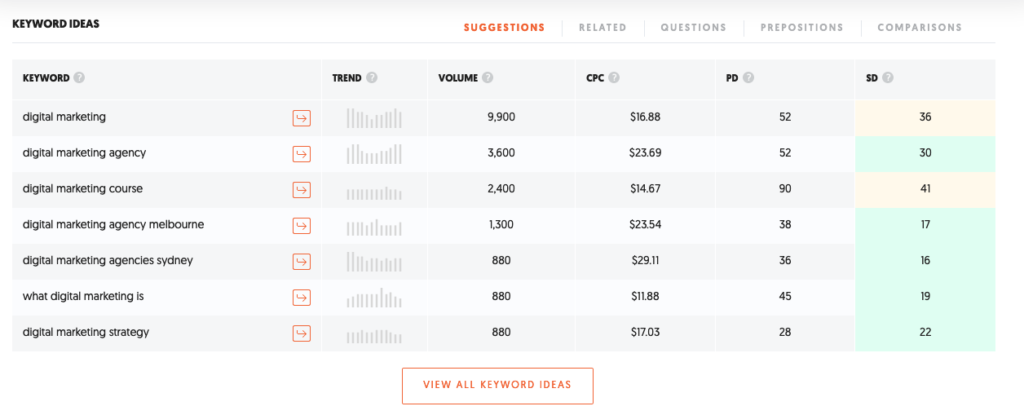Boosting your visibility online begins with using the right keywords. But how do you choose and use keywords effectively? Here’s a simple, step-by-step guide to help your business content stand out.
Step 1: Start with keyword research.
Keyword research helps you understand what your customers are searching for and their intent behind those searches. Use keyword research tools such as Google’s Keyword Planner, SEMrush or Ahrefs to:
- Discover popular search terms
- Evaluate search volume and competition
- Identify the intent (informational, transactional, navigational)
- Find related terms to include in your content
- Find and evaluate if KD (Keyword Difficulty) is appropriate
- Examine Competitors – Check their DR (Domain rating) and see if you can compete with them.
Here’s a screenshot from Neil Patel’s free keyword tool Ubersuggest. We’ll use this to illustrate the different keyword elements below, but you will see similar figures if you’re using a different tool.

RELATED: 9 basic SEO tips to help boost your Google rank.
Step 2: Determine keyword intent.
Understanding intent helps tailor your content to your audience’s needs:
- Informational intent: Searchers looking for answers or advice (e.g. ‘how to fix a leaky tap)
- Transactional intent: Users intending to purchase (e.g. ‘buy kitchen taps online’)
- Navigational intent: Visitors looking for a specific website or brand (e.g. ‘ABC Plumbing Sydney’).
Match your content style and information to meet this intent.
Step 3: Place keywords strategically.
Once you’ve chosen your keywords, placement matters:
- Meta titles: Clearly include your primary keyword at the start of the meta title. Keep it concise and appealing.
- Example: ‘Leaky tap repairs Sydney | ABC Plumbing’
- H1 headings: Use your main keyword naturally in your main heading (H1).
- Example: ‘Affordable leaky tap repairs in Sydney’.
Step 4: Integrate keywords naturally into your content.
Avoid keyword stuffing, as it makes your content hard to read and negatively impacts SEO. Instead:
- Sprinkle primary and secondary keywords throughout your paragraphs, subheadings (H2, H3) and bullet points
- Include related terms from your keyword research to enhance relevance
- Aim for readability and relevance.
RELATED: Your simple SEO checklist: Optimising your content.
Step 5: Optimise meta descriptions.
While meta descriptions don’t directly impact rankings, they encourage clicks. Include your primary keyword clearly to match user intent.
- Example: ‘Need leaky tap repairs in Sydney? ABC Plumbing offers fast, reliable plumbing services. Call now for a quote!’
Step 6: On-page keywords and local SEO.
On-page keyword optimisation is crucial for ensuring search engines understand the focus of your content. Pay special attention to:
- Title tags, headings, categories and URL mapping
- Image alt text
- Contextual keywords throughout your copy.
Local SEO is particularly important for businesses targeting specific geographic areas. Include location-specific keywords naturally in your content to improve local search visibility.
Takeaways.
Effective keyword integration is essential for improving your visibility online. Focus on keyword intent, strategic placement and natural integration for content that both readers and search engines love.
How digital marketing from Yellow Pages helps your business grow online.
The team at Yellow Pages provides expert digital marketing advice and products that boost your business’ online presence. From an online listing to digital display or social media ads, we’ll tailor a digital marketing strategy designed for your business. Find out more.
